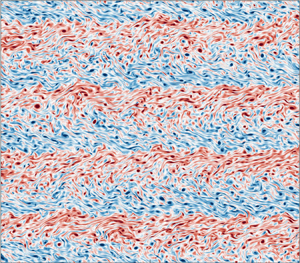Article contents
Advective structure functions in anisotropic two-dimensional turbulence
Published online by Cambridge University Press: 19 April 2021
Abstract

In inertial-range turbulence, structure functions can diagnose transfer or dissipation rates of energy and enstrophy, which are difficult to calculate directly in flows with complex geometry or sparse sampling. However, existing relations between third-order structure functions and these rates only apply under isotropic conditions. We propose new relations to diagnose energy and enstrophy dissipation rates in anisotropic two-dimensional (2-D) turbulence. These relations use second-order advective structure functions that depend on spatial increments of vorticity, velocity, and their advection. Numerical simulations of forced-dissipative anisotropic 2-D turbulence are used to compare new and existing relations against model-diagnosed dissipation rates of energy and enstrophy. These simulations permit a dual cascade where forcing is applied at an intermediate scale, energy is dissipated at large scales, and enstrophy is dissipated at small scales. New relations to estimate energy and enstrophy dissipation rates show improvement over existing methods through increased accuracy, insensitivity to sampling direction, and lower temporal and spatial variability. These benefits of advective structure functions are present under weakly anisotropic conditions, and increase with the flow anisotropy as third-order structure functions become increasingly inappropriate. Several of the structure functions also show promise for diagnosing the forcing scale of 2-D turbulence. Velocity-based advective structure functions show particular promise as they can diagnose both enstrophy and energy cascade rates, and are robust to changes in the effective resolution of local derivatives. Some existing and future datasets that are amenable to advective structure function analysis are discussed.
Information
- Type
- JFM Papers
- Information
- Copyright
- © The Author(s), 2021. Published by Cambridge University Press
References
REFERENCES
- 7
- Cited by


